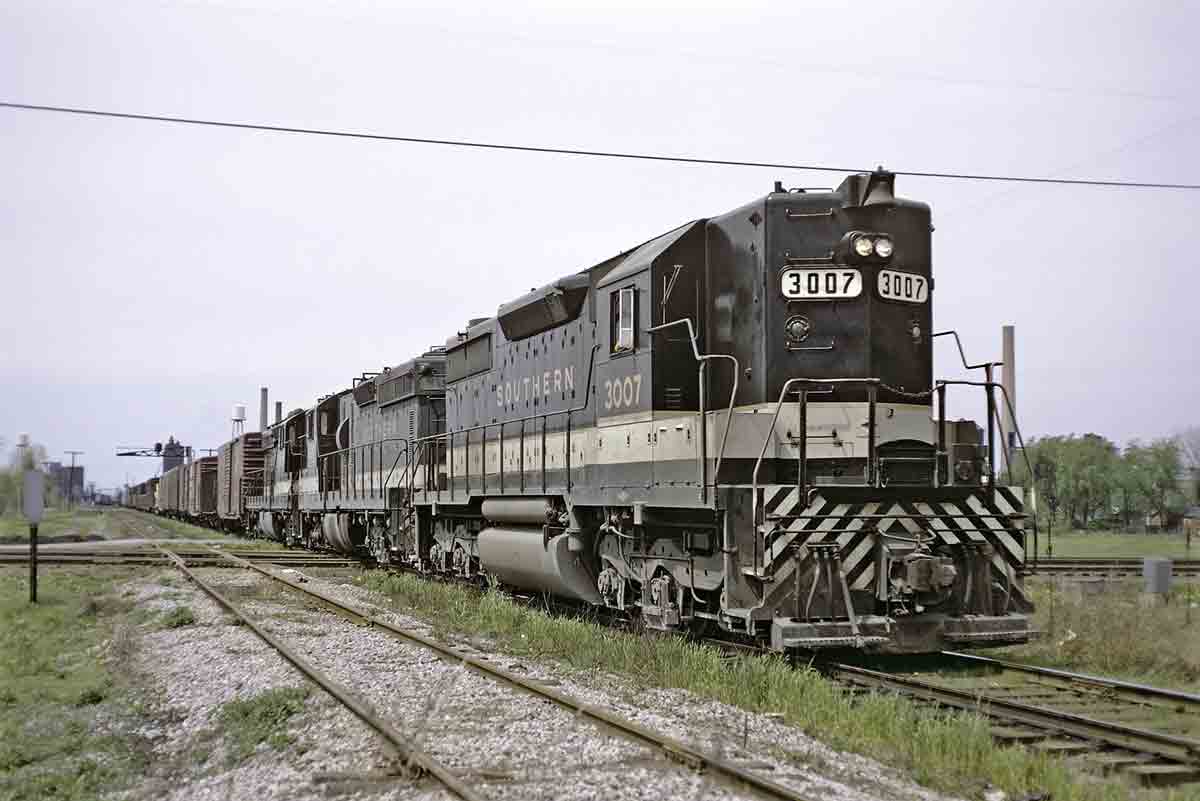Before my employment with Trains magazine began in 1971, two such invitations stand out in memory. The second, on the eve of Amtrak when I went east to cover some lines and trains that would be gone come May 1, was an invitation I could take advantage of. It came on the Penn Central in Indiana, during a station stop on Chicago–Cincinnati train 66, when I went forward to take a photo. The engineer leaned out and invited me up into his E7’s cab, and after making sure the conductor knew where I was (since my bags were in the coach), I rode up front for a couple of station stops, then went back to the cushions.
I could not accept the previous invitation. The date was Sunday, April 21, 1968. I was employed by the morning newspaper in Springfield, Ill., which meant I went to work at 5:30 p.m., usually except Friday and one other evening each week. I was prowling around East St. Louis, 90 miles from home and a frequent “target” for photography, as it was served by 13 Class I railroads plus a few terminal roads and short lines.
I’d been drawn south by a charter move on Norfolk & Western’s Blue Bird of the open-platform heavyweight parlor car City of Lafayette and two coaches, by a group of friends in the Michigan Railroad Club I knew from my old Detroit-area days. They’d come down on the rear of the Wabash Cannon Ball on Saturday and were going north to Chicago this next morning. After visiting with them and taking photos at St. Louis Union Station, I drove over to Granite City, Ill., for a farewell photo sequence. Then I began moseying around, having the rest of midday free to kill.
By the time I was offered the cab ride, already in my notebook for the day were shots of such things as Chicago & Eastern Illinois FP7s and Geeps, PC’s St. Louis passenger trains with E8s still in PRR Tuscan red, a rare Louisville & Nashville F unit, Illinois Central’s Green Diamond, and two Norfolk & Western transfers, one behind a “Pocahontas region” high-nose GP35.
Then I was out in southern East St. Louis at a diamond whose name I never knew, where Southern’s St. Louis main crossed the belt line of terminal pike Alton & Southern. The site is just east of Southern’s cramped Coapman Yard.
A Southern freight was getting ready to depart for points east, which would be Centralia, Mount Vernon, and Mount Carmel, Ill.; Princeton, Huntingburg, and New Albany, Ind.; and Louisville, Ky. Up front were an SD35 and two SD24s, while mid-train, next to a “remote control car,” were two “slaves,” SD45s controlled from the engineer in the SD35. They were pumping their air, and after I got a photo or two, the engineer beckoned me over.
He motioned me up, so I boarded the rear steps of the unit and walked forward into the cab. “Wanna ride along with us?” he asked.
Sadly, I had to decline. I was alone, didn’t want to leave my car parked in that area, and besides, I had to be at work in a few hours, with no way back from Centralia, or wherever, let alone take up the time to ride over there. We chatted a bit, and after the engineer backed up to clear the diamonds for his final brake test, an A&S RS2 on a transfer move clattered across the diamonds. I photographed it, then disembarked and readied for a “farewell sequence” as the freight left town without me.
I can count on perhaps one hand the number of Southern freights I photographed in the East St. Louis area over the years. Southern wasn’t “handy” to our usual St. Louis circuit, and I’d seen a lot of the railroad during my year at the University of Tennessee in Knoxville during 1965–66. I wasn’t yet into riding “rare mileage” per se, but I hated to miss that ride opportunity, just on general principles. Two years later, I would ride eastward, to Mount Vernon, and right out of St. Louis Union Station, in coaches behind reborn, green 2-8-2 4501 on a steam excursion, the Southern’s first out of St. Louis. In early 1968, though, who knew the Mikado would be coming to that far corner of the Southern?
First published in Summer 2010 Classic Trains magazine.
Learn more about railroad history by signing up for the Classic Trains e-mail newsletter. It’s a free monthly e-mail devoted to the golden years of railroading.















‘Twas ever thus … at Sudbury, Ontario in October 1977 I was photographing CPR’s Canadian as the Montreal and Toronto sections separated, when the fireman of the Montreal section yelled down, offering me a cab ride east. All my gear was in a Toronto-bound sleeper, so i had to decline. Never did collect the Sudbury-Montreal mileage, either.